Mechanical Behaviors in Janus Transition-Metal Dichalcogenides: A Molecular Dynamics Simulation
Abstract
:1. Introduction
2. Method and Technique Details
3. Results and Discussions
3.1. Anisotropy
3.2. Temperature-Dependent Failure Modes
3.3. Strain Rate Effect
4. Conclusions
Author Contributions
Funding
Conflicts of Interest
References
- Chhowalla, M.; Liu, Z.; Zhang, H. Two-Dimensional Transition Metal Dichalcogenide (TMD) Nanosheets. Chem. Soc. Rev. 2015, 44, 2584–2586. [Google Scholar] [CrossRef] [PubMed]
- Wang, Q.H.; Kalantar-Zadeh, K.; Kis, A.; Coleman, J.N.; Strano, M.S. Electronics and Optoelectronics of Two-Dimensional Transition Metal Dichalcogenides. Nat. Nanotechnol. 2012, 7, 699–712. [Google Scholar] [CrossRef] [PubMed]
- Cao, T.; Wang, G.; Han, W.; Ye, H.; Zhu, C.; Shi, J.; Niu, Q.; Tan, P.; Wang, E.; Liu, B.; et al. Valley-Selective Circular Dichroism of Monolayer Molybdenum Disulphide. Nat. Commun. 2012, 3, 887. [Google Scholar] [CrossRef] [PubMed] [Green Version]
- Kuc, A.; Zibouche, N.; Heine, T. Influence of Quantum Confinement on the Electronic Structure of the Transition Metal Sulfide TS2. Phys. Rev. B 2011, 83, 245213. [Google Scholar] [CrossRef] [Green Version]
- Zhang, H.; Liu, L.-M.; Lau, W.-M. Dimension-Dependent Phase Transition and Magnetic Properties of VS2. J. Mater. Chem. 2013, 1, 10821–10828. [Google Scholar] [CrossRef]
- Wen, X.; Gong, Z.; Li, D. Nonlinear Optics of Two-Dimensional Transition Metal Dichalcogenides. InfoMat 2019, 1, 317–337. [Google Scholar] [CrossRef] [Green Version]
- Thanh, V.V.; Van, N.D.; Truong, D.V.; Saito, R.; Hung, N.T. First-Principles Study of Mechanical, Electronic and Optical Properties of Janus Structure in Transition Metal Dichalcogenides. Appl.Surf. Sci. 2020, 526, 146730. [Google Scholar] [CrossRef]
- Ying, P.; Zhang, J.; Zhong, Z. Mechanical Properties of Monolayer Ternary Transitional Metal Dichalogenides MoS2xTe2(1-X): A Molecular Dynamics Study. J. Appl. Phys. 2019, 126, 215105. [Google Scholar] [CrossRef]
- Yue, Q.; Kang, J.; Shao, Z.; Zhang, X.; Chang, S.; Wang, G.; Qin, S.; Li, J. Mechanical and Electronic Properties of Monolayer MoS2 under Elastic Strain. Phys. Lett. A 2012, 376, 1166–1170. [Google Scholar] [CrossRef]
- Qian, X.; Liu, J.; Fu, J.; Li, J. Quantum Spin Hall Effect in Two-Dimensional Transition Metal Dichalcogenides. Science 2014, 346, 1344–1347. [Google Scholar] [CrossRef] [Green Version]
- Yang, F.; Shang, J.; Kou, L.; Li, C.; Deng, Z. Computational Investigation of Orderly Doped Transition Metal Dichalcogenides: Implications for Nanoscale Optoelectronic Devices. ACS Appl. Nano Mater. 2022, 5, 3824–3831. [Google Scholar] [CrossRef]
- Lebègue, S.; Eriksson, O. Electronic Structure of Two-Dimensional Crystals Fromab Initiotheory. Phys. Rev. B 2009, 79, 115409. [Google Scholar] [CrossRef] [Green Version]
- Li, F.; Wei, W.; Wang, H.; Huang, B.; Dai, Y.; Jacob, T. Intrinsic Electric Field-Induced Properties in Janus MoSSe Van Der Waals Structures. J. Phys. Chem. Lett. 2019, 10, 559–565. [Google Scholar] [CrossRef] [PubMed]
- Li, R.; Cheng, Y.; Huang, W. Recent Progress of Janus 2d Transition Metal Chalcogenides: From Theory to Experiments. Small 2018, 14, e1802091. [Google Scholar] [CrossRef]
- Lu, A.-Y.; Zhu, H.; Xiao, J.; Chuu, C.-P.; Han, Y.; Chiu, M.-H.; Cheng, C.-C.; Yang, C.-W.; Wei, K.-H.; Yang, Y.; et al. Janus Monolayers of Transition Metal Dichalcogenides. Nat. Nanotechnol. 2017, 12, 744–749. [Google Scholar] [CrossRef] [PubMed] [Green Version]
- Zhang, L.; Yang, Z.; Gong, T.; Pan, R.; Wang, H.; Guo, Z.; Zhang, H.; Fu, X. Recent Advances in Emerging Janus Two-Dimensional Materials: From Fundamental Physics to Device Applications. J. Mater. Chem. A 2020, 8, 8813–8830. [Google Scholar] [CrossRef]
- Zhou, W.; Chen, J.; Yang, Z.; Liu, J.; Ouyang, F. Geometry and Electronic Structure of Monolayer, Bilayer, and Multilayer Janus Wsse. Phys. Rev. B 2019, 99, 075160. [Google Scholar] [CrossRef]
- Hu, T.; Jia, F.; Zhao, G.; Wu, J.; Stroppa, A.; Ren, W. Intrinsic and Anisotropic Rashba Spin Splitting in Janus Transition-Metal Dichalcogenide Monolayers. Phys. Rev. B 2018, 97, 235404. [Google Scholar] [CrossRef]
- Ahammed, R.; Jena, N.; Rawat, A.; Mohanta, M.K.; Dimple; De Sarkar, A. Ultrahigh out-of-Plane Piezoelectricity Meets Giant Rashba Effect in 2d Janus Monolayers and Bilayers of Group Iv Transition-Metal Trichalcogenides. J. Phys. Chem. C 2020, 124, 21250–21260. [Google Scholar] [CrossRef]
- Yuan, J.; Yang, Y.; Cai, Y.; Wu, Y.; Chen, Y.; Yan, X.; Shen, L. Intrinsic Skyrmions in Monolayer Janus Magnets. Phys. Rev. B 2020, 101, 094420. [Google Scholar] [CrossRef] [Green Version]
- Cai, H.; Gao, Y.; Gao, H.; Guo, W. Tribo-Piezoelectricity in Janus Transition Metal Dichalcogenide Bilayers: A Frst-Principles Study. Nano Energy 2019, 56, 33–39. [Google Scholar] [CrossRef]
- Li, F.; Wei, W.; Zhao, P.; Huang, B.; Dai, Y. Electronic and Optical Properties of Pristine and Vertical and Lateral Heterostructures of Janus MoSSe and WSSe. J. Phys. Chem. Lett. 2017, 8, 5959–5965. [Google Scholar] [CrossRef] [PubMed]
- Xia, C.; Xiong, W.; Du, J.; Wang, T.; Peng, Y.; Li, J. Universality of Electronic Characteristics and Photocatalyst Applications in the Two-Dimensional Janus Transition Metal Dichalcogenides. Phys. Rev. B 2018, 98, 165424. [Google Scholar] [CrossRef]
- Zhao, J.; Kou, L.; Jiang, J.-W.; Rabczuk, T. Tension-Induced Phase Transition of Single-Layer Molybdenum Disulphide (MoS2) at Low Temperatures. Nanotechnology 2014, 25, 295701. [Google Scholar] [CrossRef] [PubMed]
- Zhao, J.; Jiang, J.-W.; Rabczuk, T. Temperature-Dependent Mechanical Properties of Single-Layer Molybdenum Disulphide: Molecular Dynamics Nanoindentation Simulations. Appl. Phys. Lett. 2013, 103, 231913. [Google Scholar] [CrossRef]
- Jiang, J.-W.; Park, H.S.; Rabczuk, T. Molecular Dynamics Simulations of Single-Layer Molybdenum Disulphide (MoS2): Stillinger-Weber Parametrization, Mechanical Properties, and Thermal Conductivity. J. Appl. Phys. 2013, 114, 064307. [Google Scholar] [CrossRef] [Green Version]
- Jiang, J.-W. Misfit Strain-Induced Buckling for Transition-Metal Dichalcogenide Lateral Heterostructures: A Molecular Dynamics Study. Acta Mech. Solida Sin. 2019, 32, 17–28. [Google Scholar] [CrossRef] [Green Version]
- Plimpton, S. Fast Parallel Algorithms for Short-Range Molecular Dynamics. J. Comput. Phys. 1995, 117, 1–19. [Google Scholar] [CrossRef] [Green Version]
- Luo, Y.F.; Pang, Y.; Tang, M.; Song, Q.; Wang, M. Electronic Properties of Janus MoSSe Nanotubes. Comput. Mater. Sci. 2019, 156, 315–320. [Google Scholar] [CrossRef]
- Han, Y.; Chen, P.; Zhang, C.; Dong, J.; Liu, H. The Buckling Behavior of Single-Layer MoS2 Sheets with Kirigami-Inspired Structures under Compression. Comput. Mater. Sci. 2021, 188, 110188. [Google Scholar] [CrossRef]
- Stukowski, A. Visualization and Analysis of Atomistic Simulation Data with Ovito–the Open Visualization Tool. Modell. Simul. Mater. Sci. Eng. 2010, 18, 015012. [Google Scholar] [CrossRef]
- Dadrasi, A.; Albooyeh, A.R.; Hamed Mashhadzadeh, A. Mechanical Properties of Silicon-Germanium Nanotubes: A Molecular Dynamics Study. Appl. Surf. Sci. 2019, 498, 143867. [Google Scholar] [CrossRef]
- Yi, L.; Yin, Z.; Zhang, Y.; Chang, T. A Theoretical Evaluation of the Temperature and Strain-Rate Dependent Fracture Strength of Tilt Grain Boundaries in Graphene. Carbon 2013, 51, 373–380. [Google Scholar] [CrossRef]
- Xin, L.; Dapeng, C.; Aiping, Y. Effects of Structure, Temperature, and Strain Rate on Mechanical Properties of Sige Nanotube. J. Phys. Chem. C 2010, 114, 4309–4316. [Google Scholar]
- Yang, Z.; Huang, Y.; Ma, F.; Sun, Y.; Xu, K.; Chu, P.K. Temperature and Strain-Rate Effects on the Deformation Behaviors of Nano-Crystalline Graphene Sheets. Eur. Phys. J. B 2015, 88, 135. [Google Scholar] [CrossRef]
- Yaghoobi, M.; Voyiadjis, G.Z. The Effects of Temperature and Strain Rate in Fcc and Bcc Metals During Extreme Deformation Rates. Acta Mater. 2018, 151, 1–10. [Google Scholar] [CrossRef]
- Po-Hsien, S.; Tei-Chen, C. Studies of Crack Growth and Propagation of Single-Crystal Nickel by Molecular Dynamics. Comput. Mater. Sci. 2015, 102, 151–158. [Google Scholar]
- Gowthaman, S.; Jagadeesha, T. Study on the Effect of Temperature and Strain Rate on Ni2FeCrCuAl High Entropy Alloy: A Molecular Dynamics Study. Mater. Res. Express 2021, 3, 045042. [Google Scholar] [CrossRef]
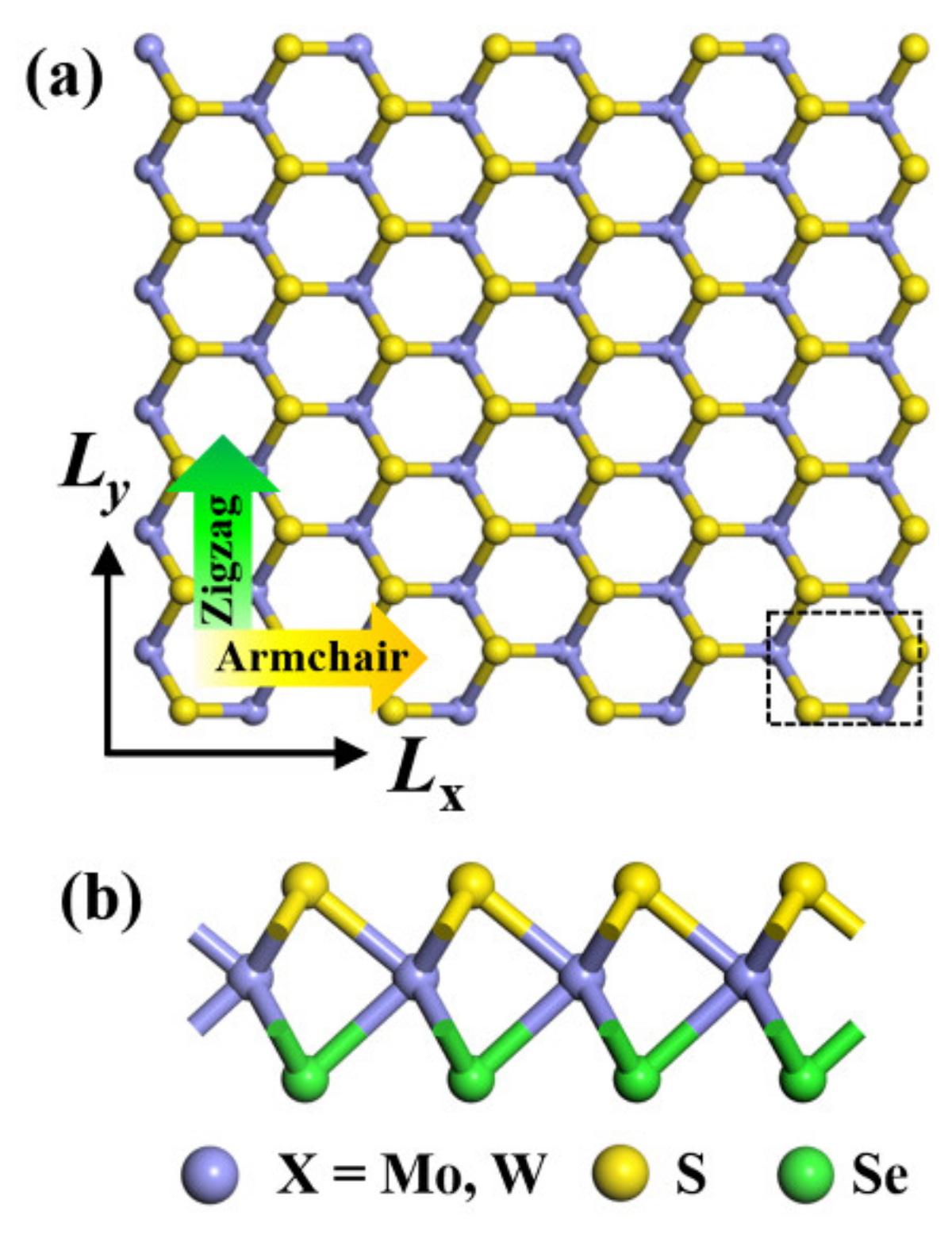
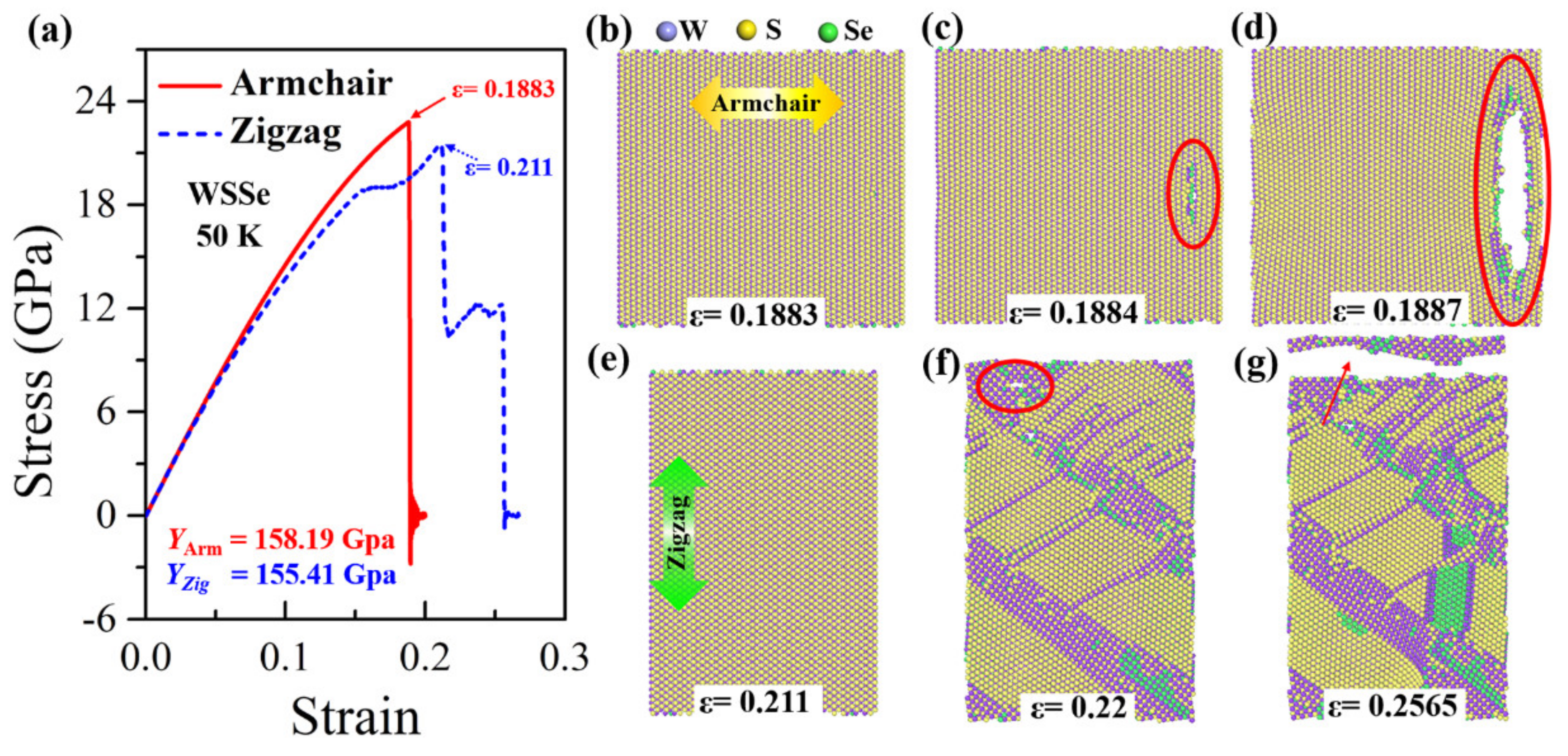

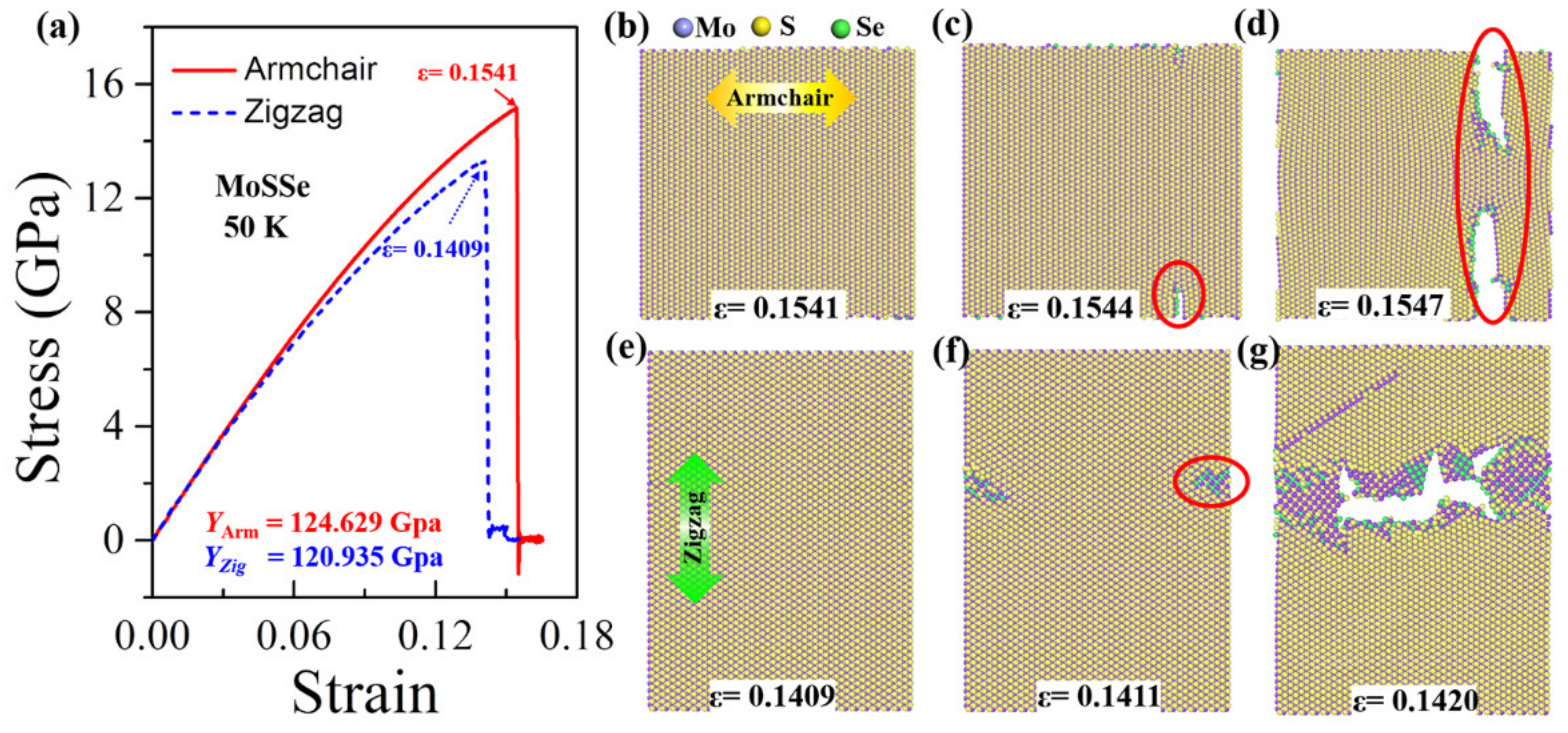
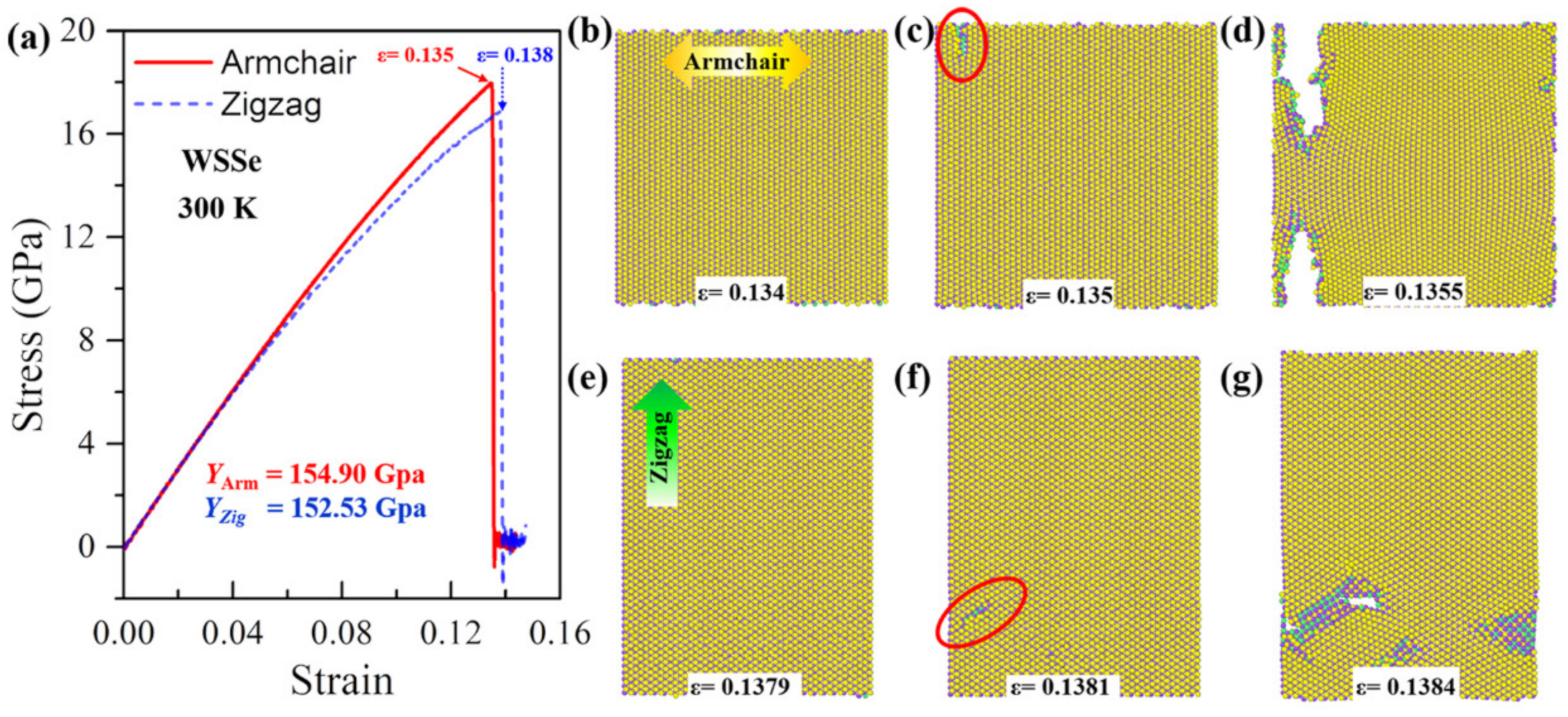
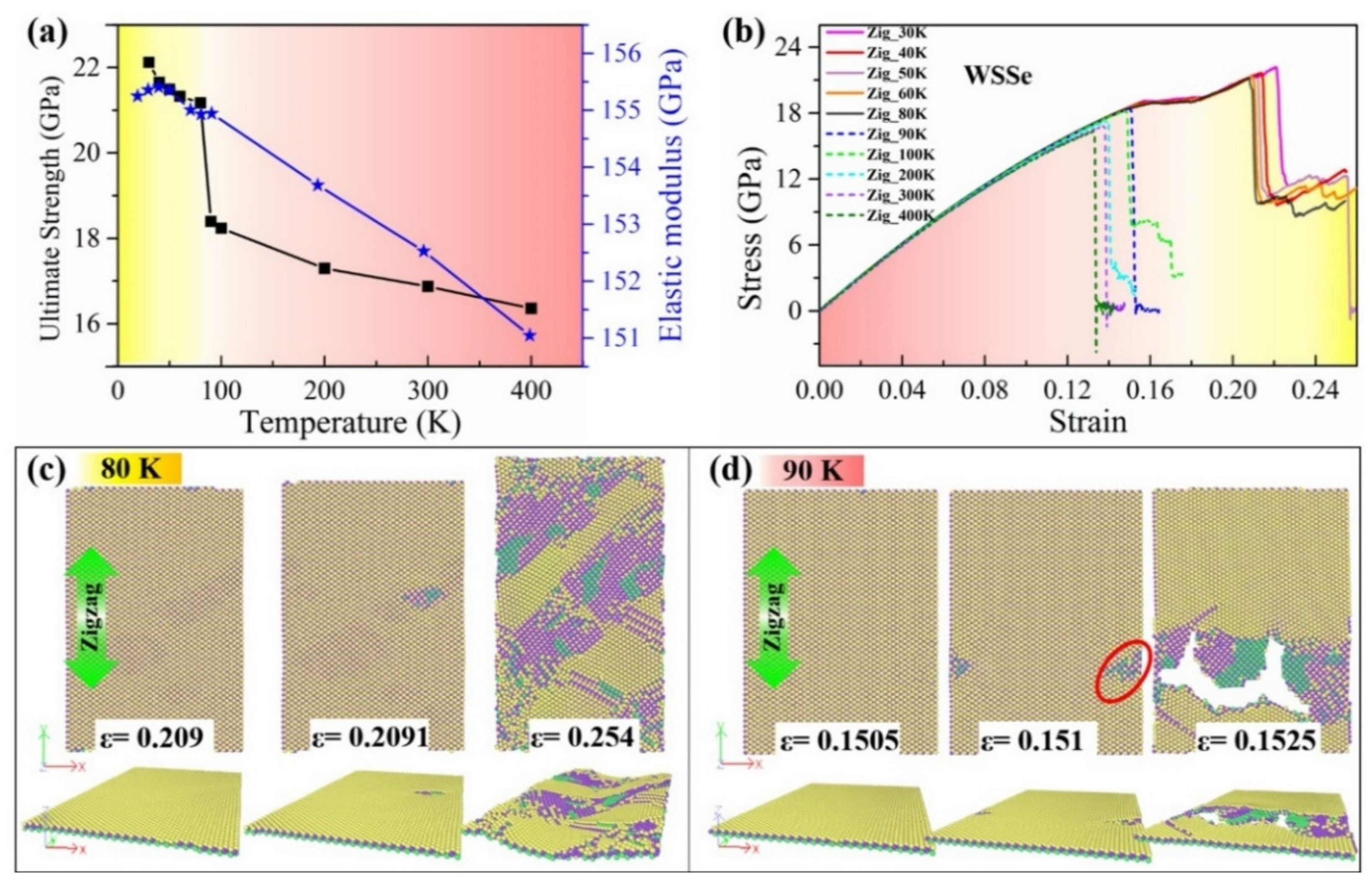

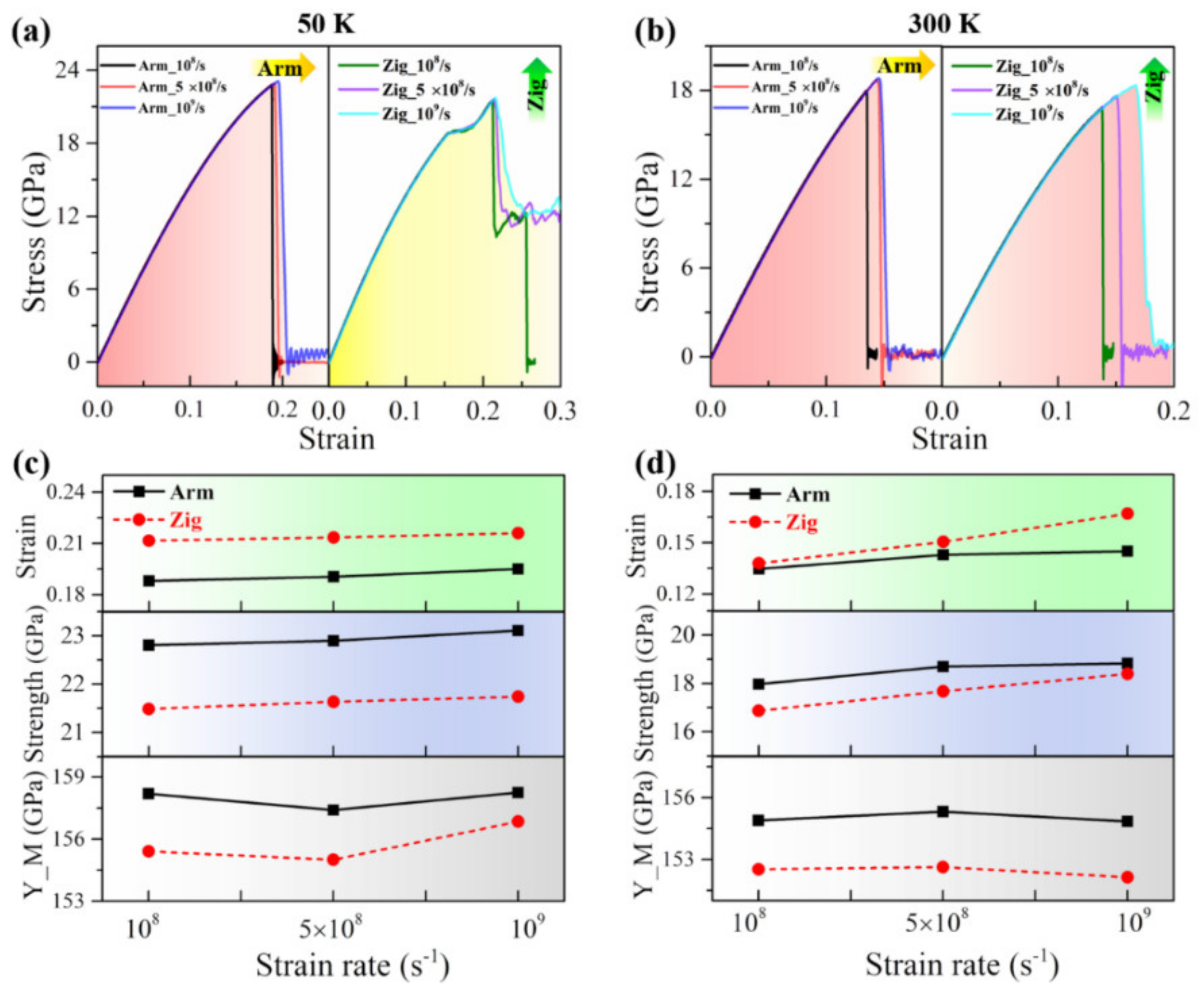
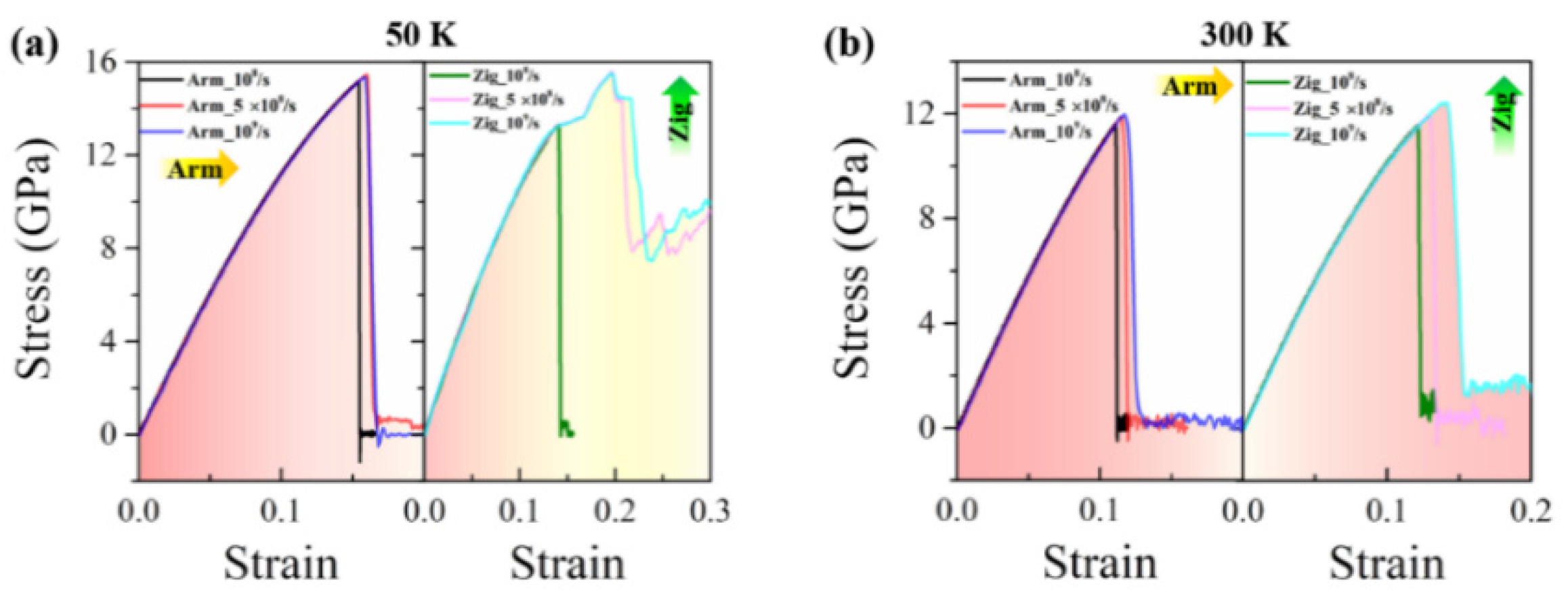

Publisher’s Note: MDPI stays neutral with regard to jurisdictional claims in published maps and institutional affiliations. |
© 2022 by the authors. Licensee MDPI, Basel, Switzerland. This article is an open access article distributed under the terms and conditions of the Creative Commons Attribution (CC BY) license (https://creativecommons.org/licenses/by/4.0/).
Share and Cite
Yang, F.; Shang, J.; Kou, L.; Li, C.; Deng, Z. Mechanical Behaviors in Janus Transition-Metal Dichalcogenides: A Molecular Dynamics Simulation. Nanomaterials 2022, 12, 1910. https://doi.org/10.3390/nano12111910
Yang F, Shang J, Kou L, Li C, Deng Z. Mechanical Behaviors in Janus Transition-Metal Dichalcogenides: A Molecular Dynamics Simulation. Nanomaterials. 2022; 12(11):1910. https://doi.org/10.3390/nano12111910
Chicago/Turabian StyleYang, Fan, Jing Shang, Liangzhi Kou, Chun Li, and Zichen Deng. 2022. "Mechanical Behaviors in Janus Transition-Metal Dichalcogenides: A Molecular Dynamics Simulation" Nanomaterials 12, no. 11: 1910. https://doi.org/10.3390/nano12111910
APA StyleYang, F., Shang, J., Kou, L., Li, C., & Deng, Z. (2022). Mechanical Behaviors in Janus Transition-Metal Dichalcogenides: A Molecular Dynamics Simulation. Nanomaterials, 12(11), 1910. https://doi.org/10.3390/nano12111910





